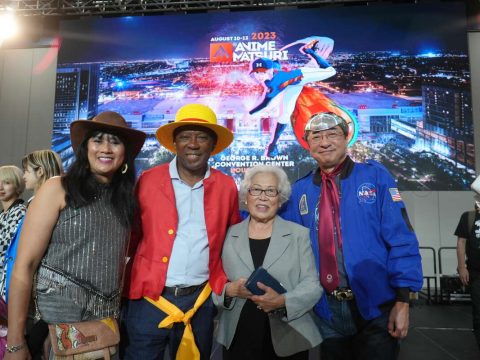The economy may be in the dumps, but with over 26,000 people having attending Otakon 2009 you sure wouldn’t know it. Granted, that’s roughly the same as 2008, but to just hold steady demonstrates that even though money is tight, people will still come out for the big show, and on the East Coast it’s the self-proclaimed “Convention for Otaku Generation.”
Otakon is so big that you have to book your hotel roughly a year in advance just to get a spot. Why, by the time you read this, the Days Inn is probably already booked solid! The downside to this is that you have to commit to attending the convention long before any guests, events, or programming schedules are confirmed. And unlike every other convention ever, you are not permitted to cancel your hotel room reservation up to 24 hours prior to check-in. So even though Otakon overall held roughly the same attendance, the addition of an entirely new hotel meant those same people were now spread out across more rooms. An awful lot of people ended up paying way, way more for their hotel rooms as they would have liked because of this.
A collective sigh was breathed mere weeks before, as it wasn’t until the deadline to cancel one’s hotel reservation had already passed that most of the major guest list was confirmed. Lots of fans turn out for the voice actor guests—Otakon has both English and Japanese ones—as well as the musical acts, but I didn’t bother to see a single one of these people. Of all the non-musical act Japanese guests, the one most fans were likely to be interested in was Yutaka Yamamoto, the director of The Melancholy of Haruhi Suzumiya and Kannagi. I find it fascinating how he can so vociferously lament the state of anime and express such disdain for choreographed dance sequence OP/EDs when he himself is the one who conjured forth that beast. Does he not realize that was never a factor until HE made it one? That guy needs to take some responsibility for his crimes! Also, Kannagi is extremely average even by moe show standards, so we didn’t bother to interview him. Instead, look forward to our [brief] interview with the fascinating Fred Schodt (pronounced the same as “shot”), and perhaps the highlights of the group press conference with Masao Maruyama, Noboru Ishiguro, Yukio Kikukawa, and Hidenori Matsubara in the near future! While many con guests tend to vanish from the grounds during the times they’re not scheduled to be doing something, Maruyama and Ishiguro were both quite content to just walk around the convention by themselves, without any special badges or security escort or anything. Hey, they’re old Japanese men. They know that fans won’t recognize them.
Normally when you read a con report on the Internet, all you hear about are attendance figures, guests, concerts, and you see pictures of who was in costume. This one’s no exception, but that doesn’t really tell the whole story, does it? Indeed, none of those things is what has kept me coming to anime conventions for 11 years now. I personally like panels/workshops because those are what vary the most from convention to convention. In addition to two workshop rooms, Otakon has a whopping SIX panel rooms. With roughly 50 panels a day, there’s no way you can see everything you’re interested in, and most of the panels went off without a hitch. Two of my personal favorites were Legend of the Galactic Heroes: History’s Future and the slightly-inaccurately titled yet jam-packed The Best Fight Scenes from Hong Kong Cinema (as many were from mainland China and the panelist noted to me that he would have liked to get some Tony Jaa in there, perhaps “Asian Cinema” would be more apropos), which due to the schedule being so packed were held opposite one another.
I was on 4.25 panels myself; the fraction is on account that what was to be my main panel, “Anime’s Craziest Deaths,” was quickly shut down 15 minutes in once I got to Apocalypse Zero. Despite being originally serialized in Shonen Champion and therefore meant for middleschool to highschool aged boys, the grotesque nature of the villains—who tend to be freakishly mutated and partially unclothed—was deemed inappropriate for US audiences. So if you wanted to see it at Otakon—and there were a few thousand of you—make sure to get your 18+ wrist band next year, cause it’ll be late night if it’s happening. Can’t wait that long / not old enough? It’ll be at Anime Weekend Atlanta 2009, no ID check required.
Video room programming obviously varies too, but anime’s not the difficult to acquire commodity it once was: most people are perfectly content to watch the anime they want to see at home instead. I didn’t spend more than 30 seconds in any of the video rooms, but I was relieved to see there was good turnout to watch the first Urusei Yatsura movie, Giant Robo: The Day the Earth Stood Still, and Baccano!, all favorites of mine. Still, Otakon had 6 video rooms, one of which was dedicated to live-action and another of which was dedicated to “the classics.” The 35mm theater is a thing of the past, replaced by an HD theater equipped for Blu-Ray 1080p projections. Anime in high-def is still a little hard to come by in the US, so a good bit of the programming was live-action adaptations of anime instead. I for one am glad they moved the screens up so the heads of people in front of you didn’t quite block the subtitles quite so much.
Otakon’s biggest strength is the fact that it’s entirely run by fans, but if the fans change, does not the con itself change too? As I walked the hallways and bemoaned the fact that so many cosplayers see fit to pose for photos in narrow choke point areas mere feet away from more open areas while not being redirected by staff, I couldn’t help but wonder whether “anime” cons everywhere were starting to be misnomers. Sure, some (including Otakon) bill themselves as “Japanese pop culture conventions” or the like, but we’re at the point now where I can say it and do so definitively:
Anime conventions aren’t predominantly about Japanese pop culture anymore, even if the programming itself may be. The life blood of any fan convention is the attendees that are present, and therefore it’s more accurate to say that these conventions have a “con culture” of their own which is what they’re REALLY about. Click here to learn more.
I can safely say that, while interest in some facet of Asian pop culture is generally present in some degree among almost all attendees, the dominant passion of many attendees is not anime or manga or Japan-related anything. The true underlying motor of this spectacle is an amalgamation of Internet-based humor, videogames (predominantly non-Japanese ones), con-specific in-jokes, American pop culture, and anime/manga such that it’s just one interest of several, no more or less dominant than the rest instead of being the core, primary interest. The most popular costume last year at Otakon 2008 was not an anime character at all. It was the Joker as depicted in The Dark Knight. This year the most popular costume was also not an anime character: it was Rorschach from Watchmen. (DC Comics would be thrilled if all of these people proceeded to go and buy some manga they’ve released under their CMX label. PS: buy Swan!) The halls were alive with people screaming “MARCO! POLO!” between group chantings of Family Guy quotations, reciting/displaying Internet “memes,” and so on such that the main thing they have to do with that general sphere of Asian pop culture entertainment is “people of the typical age who like this stuff like that stuff too.” Whatever it is “nerdy” youths of America are interested in is what the “con culture” is about, and anime is one part of that. I’m not saying you shouldn’t have multiple interests. I’m just saying that anime cons should be about anime/manga first and everything else should be of lessened emphasis.
Based on the costumes, T-shirts, pins, signs, and such worn by the over 26,000 people present at Otakon, I estimate a full 50% of attendees were showing off their non-anime passions front and center, first and foremost: steampunk, Team Fortress 2, Marvel superheroes, GI Joe, Ghostbusters, and so on. Look, I’m not saying “they don’t like anime enough” or “they aren’t PURE fans” or anything just because they like more than just anime. But a wise, possibly drunken man once said, “despite the ‘boom’ of the recent past, anime and manga remain what they always were–foreign imports, that continue to struggle for an audience…That’s not true of many of the things U.S. fantasy and SF fans get excited about. There’s nothing wrong with Harry Potter, Star Trek, Star Wars, V for Vendetta, 300, Watchmen, or this or that English-language fantasy or sci-fi property you care to name. But why should anime and manga cons devote their limited resources to them, when the average Hollywood film’s publicity budget alone could pay for a dozen anime TV series?”
I don’t think that anime cons should, as they become larger, gradually shift their way into becoming general media cons as they seem to be doing; even Otakon’s anime video rooms included showings of Winx Club and Teenage Mutant Ninja Turtles during a children’s block on the paper-thin justification that they’re “anime-inspired.” Conventions dedicated to anime began precisely for the purposes of being separate from those media conventions in the first place. In Otakon’s case, they’re so large such that even if 75% of the con was devoted to tangentially-related pursuits, you would STILL have plenty of anime/manga-dedicated content such that you can’t cover it all, so it’s not like they’re going to tell the dedicated raver gear dealer to pack their bags and go home even though they should. But most cons aren’t as big, and yet they still have all this other stuff anyway such that anime ends up gradually getting harder to come across at the anime convention.
Otakon bills itself as the “Convention of Otaku Generation” as a play on the sub-title of Otaku no Video. But if the hall culture is anything to go by, perhaps it’s more accurate to say that it’s the “Convention of Convention Generation.”







